
Station Name: YARMOUTH SOUTH TOWN[Source:
Darren Kitson]
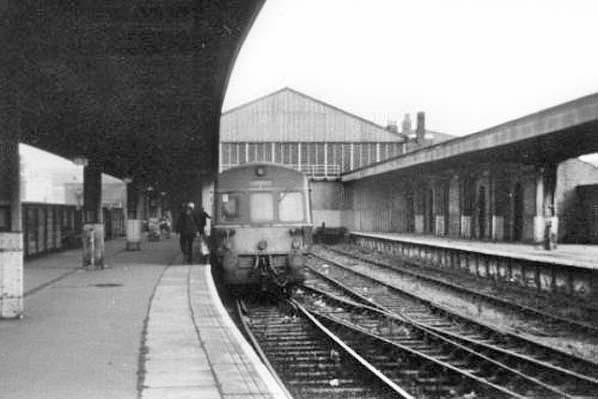
A DMU has just arrived from Lowestoft and a crew member is moving the unit's tail lamp to the other end. By the time this photograph was taken on 10 February 1968 only the former arrivals platform, Platform 3, was in use with other tracks being rusty and weed-grown as seen here. The doors and windows in the lower part of the station building have been sheeted-over, telling us that the station had become an unstaffed halt. On the right and behind the canopy the waiting rooms can be seen, provided only on what had been the departures platform. The waiting rooms once former part of the supporting wall for the trainshed, removed in 1952/53. The dark shadow at the end wall of the waiting rooms is in fact a goods van; the Up side bay was often home to a semi-abandoned departmental van or antiquated carriage but the presence of this van may have been in connection with the lifting of redundant track which commenced around this time. On the left part of the low panel fencing which had replaced the north side wall of the former train shed can be seen. Quite why this wall had to be removed and partially replaced rather than simply reducing its height is unclear. Beyond the rear of the refreshments room added by BR can just be seen. The DMU is one of the 79xxx series, or Yellow Diamond, Metro-Cammell units introduced in 1955 and which had all gone from passenger service by 1969. Often misdescribed as being Class 101, the 79xxx series differed to Class 101 in a number of ways and the two types were incompatible. 'Yellow Diamond' was the multiple unit coupling code and the symbols are just visible either side of the outermost lower marker lights. The Metro-Cammells gave good service during their short careers and anyone who remembers these and the Derby Lightweights will recall the Metro-Cammells gave a much steadier ride although both types had a tendency to bounce. A Derby Lightweight at full flight could be quite an experience. Sadly all of the perfectly serviceable Yellow Diamond sets, including the more numerous Derby Lightweights, were in a minority compared to the Blue Square units and fell victim to the many line closures of the 1960s. There had been a plan to modify them to be compatible with the Blue Square types but it was not to be. It was yet another example of money wasted as part of the 1955 Modernisation Plan which, in fairness, was well intended but badly executed. Then along came Marples, who had his fingers in the road transport and construction industry pies, and Dr Richard Beeching.
Photo by Andrew Barton from Berney Arms website 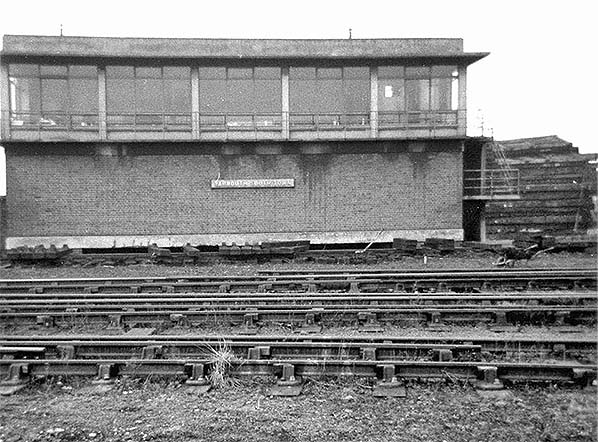 Yarmouth South Town signal box, nameboard still in position, seen here during track-lifting on 10 February 1968. Track-lifting had more or less followed on from the singling of the Lowestoft line which had largely been undertaken the previous year - a somewhat back-to-front way of doing things. Freight traffic had ended in November 1967 and South Town box closed although it is likely that the box received ground frame status during the initial phase of track-lifting, which would mean its final abolition occurred early in 1968. By the time this photograph was taken, the signal box had been disconnected and thereafter point changing (and clamping, the locking mechanisms having been disconnected) would have been done manually on location. The rails would have been sent to Chesterton Junction, Cambridge, for reuse or for scrap if worn out. Following track-lifting, the remaining single track for the Lowestoft service ran through the area immediately in front of the signal box, seen here occupied by track components. The box remained for some time as a derelict shell but when it was demolished remains unknown. It probably disappeared when the rest of the station site was cleared in 1978. South Town station was 47 chains from Yarmouth South Town Junction, the point where the Lowestoft and Beccles lines converged, this box having had a McKenzie & Holland 28-lever frame with tappet locking.
Photo by Jim Ellington 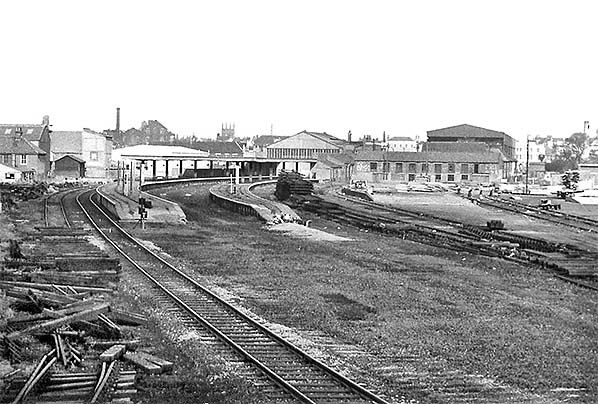
Track- lifting is underway at South Town in March 1968, this view making an interesting comparison with that from April 1967. It will be noted that the surviving Platform 4 road has been realigned following removal of pointwork; it continued on what had been the Down side, passing directly in front of the signal box (closed by this date), before swinging away towards Gorleston. The 'T' sign means 'Termination' of temporary speed limit, which would have been in force during track-lifting operations. Whilst it may seem a little silly ending a speed limit on the approach to a terminus, that was the way the rule book worked. There would also have been a Commencement warning, letter 'C', for trains departing as well as a sign telling drivers of the limit. On the right, sidings are in situ and timber merchants, probably Jewson, have taken over the coal yard and cattle dock. None of this timber would. of course. be arriving or departing by rail.
Photo
from John Mann collection
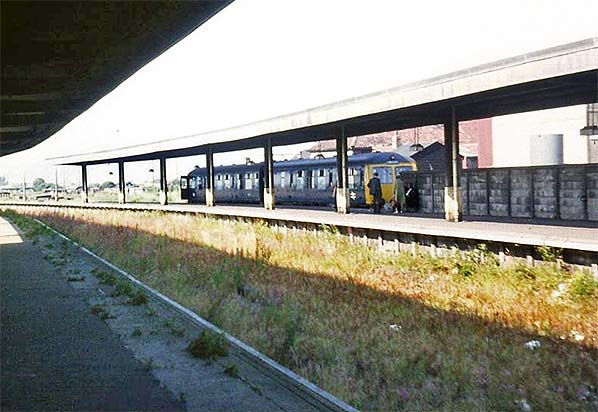
Yarmouth South Town in August 1969 and, for a refreshing change, the dereliction can be seen in colour. At Platform 4 stands a Cravens DMU, waiting time before rasping and rattling its way back to Lowestoft. Cravens and other Blue Square units had by this time all-but replaced the 79xxx units, the last of which were withdrawn from passenger service during the late summer of that year. The Cravens unit seen here is in what came to be known as Rail Blue livery with full yellow ends but without the rather unsightly extension of the yellow over the cab doors. The unit is from the early batch which lacked the two-character headcode box below the windscreens. The power car is facing the camera. This view illustrates well how Platform 4 terminated short of the station building, a legacy of the former train shed. The same applied to Platform 1, left, the difference being the presence of the waiting rooms and which are responsible for blocking out the sun in this view. References to platform numbers post 1968 are a convenience; technically once the tracks had been lifted from all bar Platform 4 the numberings became somewhat academic. The remaining single track was once the Down line to South Town but from 8 April 1968 the direction was reversed so it became the Down line from South Town. The reason for the change was because trains from South Town entered Lowestoft Central from the by-then single track in the Down direction. One might think that the change should have been made when the Beccles line closed in 1959 but this was not possible as the Lowestoft line was still double track at the time.
Photo by Brian Halford 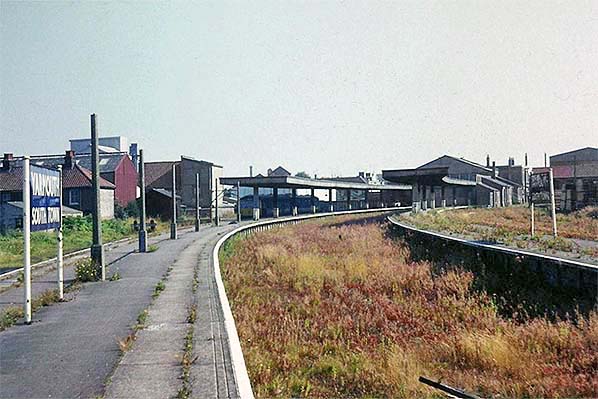
A further view from August 1969 showing the dereliction in glorious colour. Presumably it is the same Cravens DMU at the platform as was present in another colour view from the same time. The running-in boards survived until the end although that on the right had become a little bit drunk. On the left, the old maltings buildings have been replaced by modern structures. The maltings stood alongside High Mill Road, so named because of a 122ft windmill which once lofted over its surroundings. Owned by the Press family the mill was demolished in 1904 and its bricks are said to have been used to construct the houses which became Nos.35 and 36 High Mill Road, located behind and left of the camera in this view. The maltings were demolished in 1977.
Photo by Brian Halford 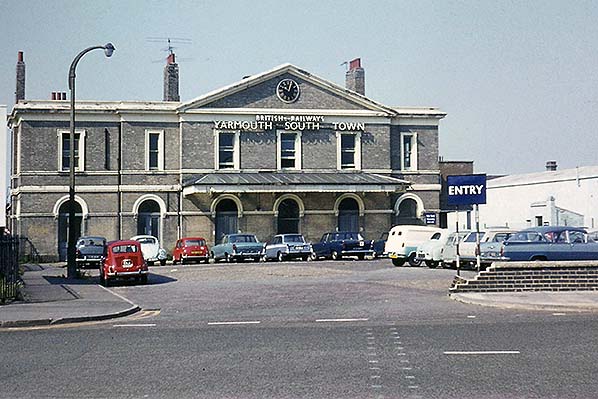 Yet another view of South Town forecourt and station building but this time in colour and taken during August 1969, nine months before closure and at the time the station had been reduced to an unstaffed halt with a single platform in use. The Entry sign was 'V' shaped and no doubt the other side read ‘No Exit’, the exit being out of view to the right. Once again we have plenty of period road vehicles present. Tucked away in the left corner is a Ford Consul MkII or perhaps a 375 which was merely a rebrand of the MkII. Still on the left and nearer the camera is a Fiat 600; these looked a little like a stretched 500 'Jelly Mould' but actually predated it. Next to the Consul is a Volkswagen Beetle, the car which began life under Adolf Hitler and known originally as the KdF-Wagen (KdF - Kraft Durch Freude or Strength through Joy, the Nazis state-controlled leisure organisation). It's registration number is DS 5969, from the original registration system which dated back to 1903 and was more familiar on prewar cars. Before the present vehicle regional registration system came into being each county issued its own registrations with some letters reserved for towns and cities (Great Yarmouth was EX, Lowestoft BJ and RT for example). Some counties were sparsely populated and this meant that registrations from the 1903 system continued to be issued into the 1960s. DS was Peeblesshire, Scotland. The final county to issue this type of registration number is thought to have been Radnorshire, Wales. Great Yarmouth was also among the last, issuing EX xxxx registrations until 1956, the last one being EX 9999, with AEX xxx appearing the following year. These registrations are not to be confused with the reversed system which appeared during the 1950s, eg 5969 DS. Both systems finally disappeared on the British mainland in 1964 with the introduction of the B suffix, the A suffix being restricted to Middlesex although in recent years it has been reused for re-registrations of classic vehicles on which it looks ridiculous. Next to the Volkswagen is a Mini, then a Ford Zephyr MkIII, a Triumph Herald and then another Zephyr. The MkIII Zephyr was distinguishable from the Zodiac by the lack of additional brightwork around its back end. There is another car, mostly hidden, to the right of the L-Plated Zephyr and it appears to be another Mini. The van is a Ford Thames 100E, based upon the 100E saloon. Next to it is an Austin A30 saloon, distinguishable from the A35 by its small rear window. Next is a Ford Escort Mk2 estate and arguably the blandest-looking of the entire Escort series but with styling typical of its time. Finally we have a very grand looking Vauxhall Cresta PA. The Cresta was supposedly the posher version of the Velox and, like the larger Fords of the time, very much mimicked American styling. This styling, along with things like column gear change, was in vogue for a decade or so but fell out of favour rather abruptly. The Cresta PA and its Velox sister were a little overstyled for British tastes but by no means ugly and certainly not as ugly as most of the hideous hatchbacks on the roads today, the styling of which, especially the back ends, can only be described as weird. Vauxhall, however, just in case anybody could not recognise their PA, placed a prominent and shiny 'V' on the extremity of the rear fins and one is just about
visible in this view. Photo by Brian Halford 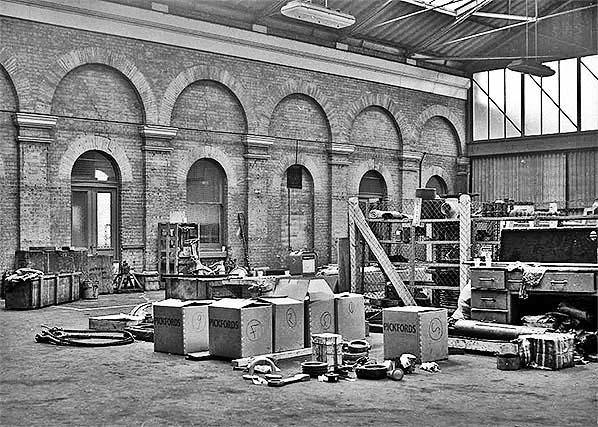
The interior of South Town station building sometime during the period BR rented the building out. There are plenty of Pickfords boxes lying around; they had likely been used for deliveries although the writer has a very vague recollection that Pickfords did use part of the building for a time. Either way, Pickfords premises were to the south of the station, backing onto the end of the coal sidings. The area seen here was the circulating area and the platforms were to the right. Where the desk with open drawer stands, right, was the approximate position of the former W H Smith bookstall. We will now continue descriptions of the various rooms on the south side of the station, those which faced onto Platform 2 being described elsewhere. The doorway at the far end was the ticket collectors’ room, No.8. To its left was the entrance to the gentlemen's toilets, No.9 room, which continued behind the next window which had been bricked-up in 1952. Behind the bricked-up section were six individual urinals with a further five along the end wall nearest the camera. Along the back wall, were five cubicles and two basins. South Town station had no ladies’ toilets, a not uncommon situation at one time. Moving along, the window to the left of the gents' was an Accounts office, within which was also a mess room partitioned off. The entrance was the doorway at far left. The Accounts office and mess which were Nos.10 and 11 rooms had been, prior to 1952, toilets but quite why it was deemed necessary to relocate the toilets next door is a mystery. On the left but out of view in this picture another doorway led into the Parcels Office, No.12 room, which has been described elsewhere. By the time this photograph was taken, most railway accoutrements had been removed and the way onto the platforms closed off with what appeared to be corrugated iron sheeting.
Photo
from John Mann collection
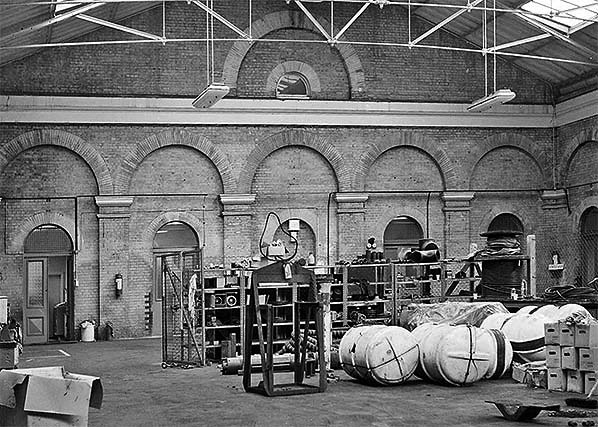
The interior of South Town station building sometime during the period when BR rented out the building. This view is looking towards the forecourt but at the inner wall, behind which was the original ticket office, other offices and the station entrance, above which was stationmaster's accommodation. The open door on the left led into the stationmaster's clerk's office, beyond which was the stationmaster's office to which there was no direct access from his domestic accommodation above. The doorway just visible at the extreme right led into the Left Luggage lobby, within which was a counter and the actual Left Luggage office which also contained, but was partially partitioned from it, the Parcels Office. At the rear of the Parcels Office were originally three windows which overlooked the tracks leading to the goods yard. In 1952 two of the three windows were removed and luggage doors installed. The surviving window was that nearest the forecourt. Quite how these luggage doors worked is by no means clear but photographs exist showing passenger and/or parcels vehicles on the goods yard siding adjacent to the doors so perhaps their purpose was luggage in advance. Nevertheless, photographic evidence suggests that Platform 1 was used for, at least, parcels more usually and staff likely found this more convenient. The sending of luggage in advance was once a common practice, especially when a large family or other large group was travelling. The cylindrical objects are lift raft pods and are usually seen on the deck of boats and ships.
Photo from John Mann collection 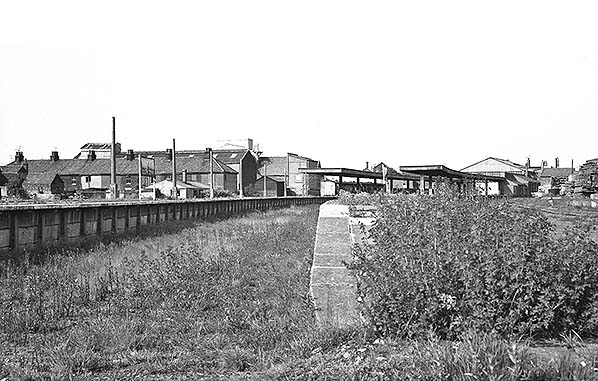
One might be forgiven for thinking that South Town was closed when this photograph was taken but this was not the case. The giveaway is the DMU lurking at Platform 4; a Metro-Cammell unit of what became Class 101 and not one of the 79xxx series. This photograph is undated but the lifted track tells us that it was taken sometime after 1968. The station's two running-in boards still stand defiantly as does the goods loading gauge, just visible to the left of the DMU. At far right, where the cattle pens and coal wharf had been, stacks of timber now reach for the sky.
Photo Steve Davis collection 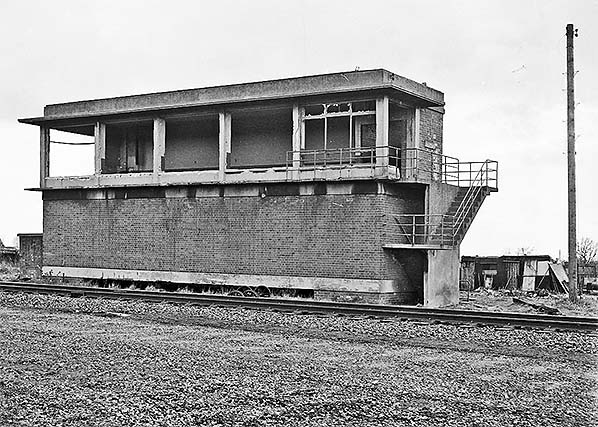
The derelict shell of South Town signal box photographed sometime after 1968, when redundant track and equipment was removed, but before May 1970 as the remaining single track is still in use. This was an ARP (Air Raid Precaution) box of which there were numerous examples around the country. The LNER constructed around twenty such boxes. ARP boxes were constructed for two reasons: first of all, when a new box was required to deal with extra wartime traffic, and secondly to replace those damaged by enemy action. South Town box was among the latter, the original being damaged during an air raid in 1942 and the structure seen here opening in 1943. 'ARP' boxes were built to withstand blast damage and incendiaries. South Town box was fairly typical of its type with substantial concrete roof and windowless locking room. Others had a blast screen around the entrance while some were protected, in part or totally, by a separate blast wall. The pre-1943 South Town box contained a 76-lever McKenzie & Holland frame but whether this frame survived to be installed in the new box is not known. That said, no record has been discovered of a new frame being provided so it might be cautiously assumed that the original did survive. One item which did survive to be transferred to the new box was the nameplate. It was positioned (it can be seen in another image) on the front, below and slightly to the right of the central window and its outline is visible here. Apart from the box another hint of modernity, for the time, is the flat bottom rail. That at the sole surviving platform, No.4, remained bullhead to the end so the length of flat bottom seen here was probably installed during 1968 when all other tracks and pointwork were lifted. A few words about bomb damage and incendiaries are in order. Apart from the obvious death and destruction caused by direct hits by aerial bombing, much damage and a proportion of deaths during WWII were caused by shock waves from the blasts. These shock waves pulsated: imagine taking a thin strip of metal or plastic and constantly bending it back and forth until it fractures - blast shock waves had a similar effect and walls of buildings would 'throb' until they either survived, once the shock waves diminished, or collapsed. This is why, in photographs showing wartime bomb damage, buildings have collapsed where they stood rather than being blown apart and masonry hurled across a wide area. Most peripheral damage (and deaths) caused by V1 flying bombs and V2 rockets occurred for the same reason. Incendiary bombs purpose was to start fires and most did so via a delayed action fuse mechanism. Second World War incendiaries generally used magnesium as the combustible agent. Dropped from aircraft, these relatively small bombs would often fall undetected or, frequently, crash through roofs and lay in lofts. The problem was, being small non high explosive devices precisely where they landed was often difficult to detect during the blackout and their presence was not always detected until it was too late. However, if they could be located within a certain, limited, time span they could be rendered harmless quite easily by immersing them in water.
Photo from John Mann collection
Click here for Yarmouth South Town Gallery 7:
 Home Page Home Page
|
